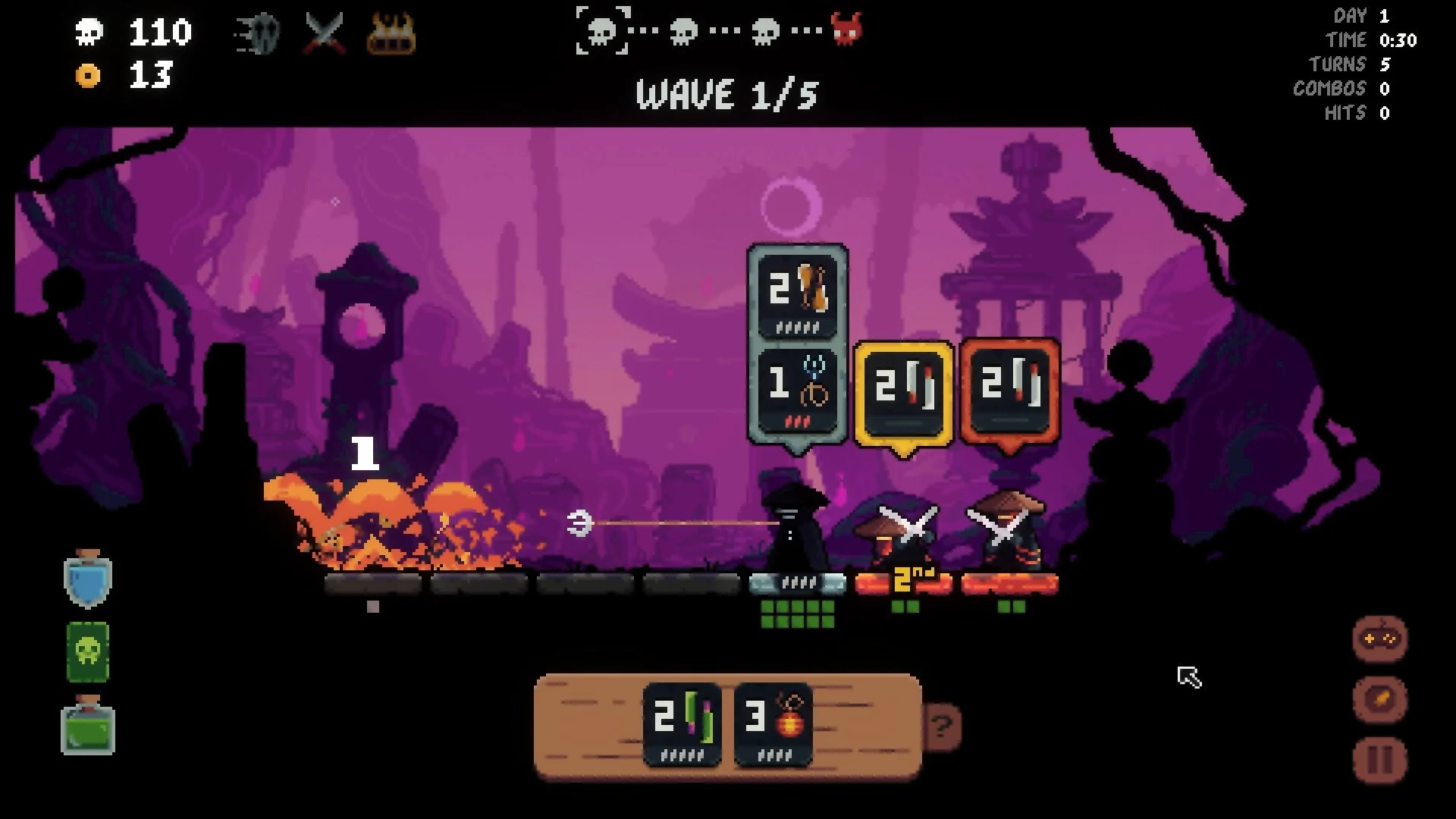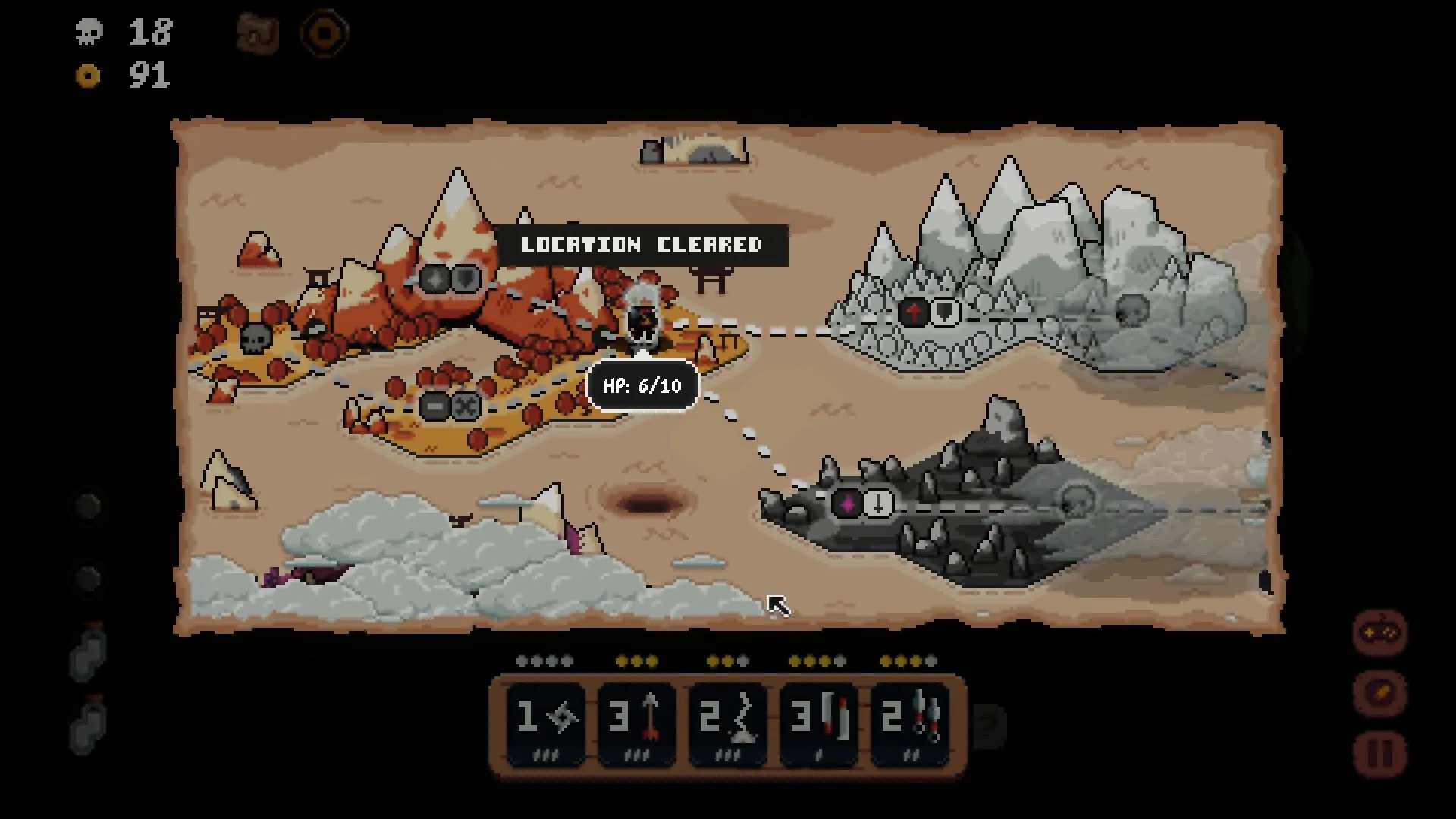Durable as a house of cards.
Regardless of the gaming genre, mistakes don’t always lead to defeat. And when they do, you can usually pick up from that failure from the last checkpoint and try again. However, when you adopt the roguelike or roguelite way of design, those mistakes can undo much or all of the progress you’ve made, often at the touch of a wrong button. Shogun Showdown, a tile-based 2D roguelite with some clever strategy elements, wears this with pride, a game that can often have you feeling like a genius one moment, and a complete idiot the next.
Shogun Showdown has a few terms that some gamers may wince at; “Roguelike”, Roguelite”, and “Deck-Building.” While games like Slay the Spire found a fairly impressive audience, the genre is nonetheless still fairly niche. To be honest, it’s not my cup of tea either, but Shogun Showdown was nonetheless interesting, even if I am still more of an outsider looking in after all is said and done. If you are a fan of the genre, then this latest by Roboatino will certainly call to you, but for those still unsure of the genre as a whole, well, this review is for you.
In Shogun Showdown, you essentially play a lone warrior out to defeat a shogun. That premise is more or less all you get. Shopkeepers will have the odd line of dialogue, but there isn’t any narrative here that you are working towards, the gameplay, visuals, and strategy of the game are essentially all there is, all of which are executed incredibly well. You can unlock new characters who have different tiles and abilities, but the focus of killing the shogun is still your goal.
Shogun Showdown is all about taking actions and using tiles that represent an attack. Battles will often be against multiple foes at once, even during boss encounters, so knowing when you should perform said action will dictate the flow of battle and whether or not you’ll come out of it unscathed. Actions consist of the following; moving forward or backward, turning around, waiting, equipping a tile, and using that tile to attack. Each tile then requires a cooldown to perform it again. Knowing when to attack, move, or wait, is the basic strategy of the game. And, without a rewind or undo button, you live or die by those choices.
Battles are not timed or have any sort of pressure to perform the action. You can analyze what is before you, how waiting and allowing an enemy to close the gap may benefit you, or how dashing through your opponent by moving toward them will open you up for a better counterattack. While Shogun Showdown is simplistic in what is available to you on the surface, the addition of new weapons and skills throughout your run deepens your arsenal of what you have to work with, not to mention items to refill your health or apply a shield. Once you start to play around with a lot of what the game has in store for you, you’ll start to see the depth that is here.
Levels will range in the amount of tiles to the number of forces that all take their turns based on their own abilities. You’ll have a set amount of enemies per wave and set amount of waves per area before you take on the boss. Some enemies can move across the entire field to strike you, so timing your moves, their movement, and those all around you, will often have you analyzing the field to determine how the next couple of moves will go. This is where the strategic element exists. Dying sets you right back at the start without the coins and skulls you’ve earned that are used to purchase new tiles throughout your run and upgrade your weapons to do more damage. While coins are earned from defeating the standard fare, skulls are only unlocked upon defeating the bosses, making future runs a tad easier when you have more tools to work with.
At first, you’ll only have the Wanderer, who comes equipped with a basic sword attack and a ranged bow. These are the two initial tiles you’ll start with. The Wanderer’s skill is being able to swap positions by moving forward through them. Eventually, you’ll unlock the Ronin, Shadow, Jujitsuka, and the Chain Master, all of which have unique tile presets and skills. The Ronin, for example. Can push back the enemy in front of them, while having access to the spear, which has a greater range than the sword, and the smoke bomb, which have you swapping position with the enemy in front of you. Each new character may borrow elements you can use across the cast, but starting with some of these skills can easily make a worthwhile run.
Visually, I am really sold on Shogun Showdown. Its pixel art is very clean and the contrasts to the backgrounds allow the characters to stand out, something that helps in making everything read very well. Some of my favorite locations were Moonlit Port, which is a nighttime setting with pagoda’s in the background, the odd light being lit up among them. Spirit Gateway, which matches the game’s title screen and artwork is solid, with the Hot Springs being my favorite as the lava channels and red trees really look great.
Shogun Showdown, despite all the tools and abilities you can rely on is brutally difficult in most circumstances, especially if you have the habit of acting before you really analyze every move or press the wrong button, something that has killed some very lengthy runs for me. Personally, I would have loved for an accessibility setting for newcomers to the genre to have some sort of undo or rewind, even if it was limited per level or run, allowing for one mistake to not ruin a nearly hour long run. Still, Shogun Showdown is a remarkably tight strategy game that looks good, feels good, and has some clever tricks to make you feel like a master tactician, just make sure to not accidentally keep pressing the turn-around button and getting a host of swords shoved through your back.
Developer - Roboatino.
Publisher - Goblinz Studio, Gamera Games, Entalto Games S.L. Released - September 5th, 2024. Available On - Nintendo Switch, PS4/PS5, Xbox One/Series X/S, PC. Rated - (E 10+) - Mild Blood, Fantasy Violence. Platform Reviewed - Nintendo Switch. Review Access - A review code was provided by the publisher for the purpose of this review.












